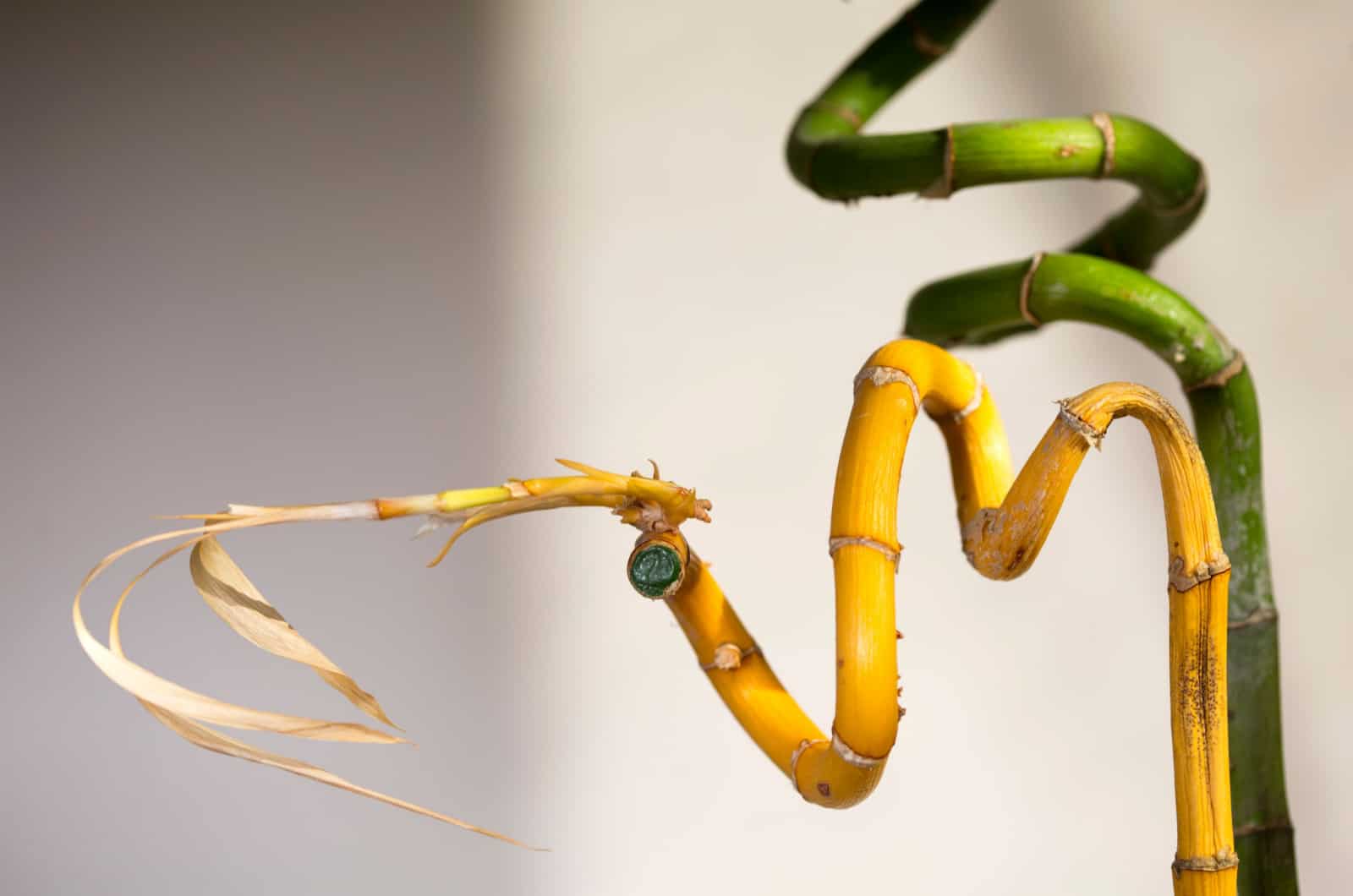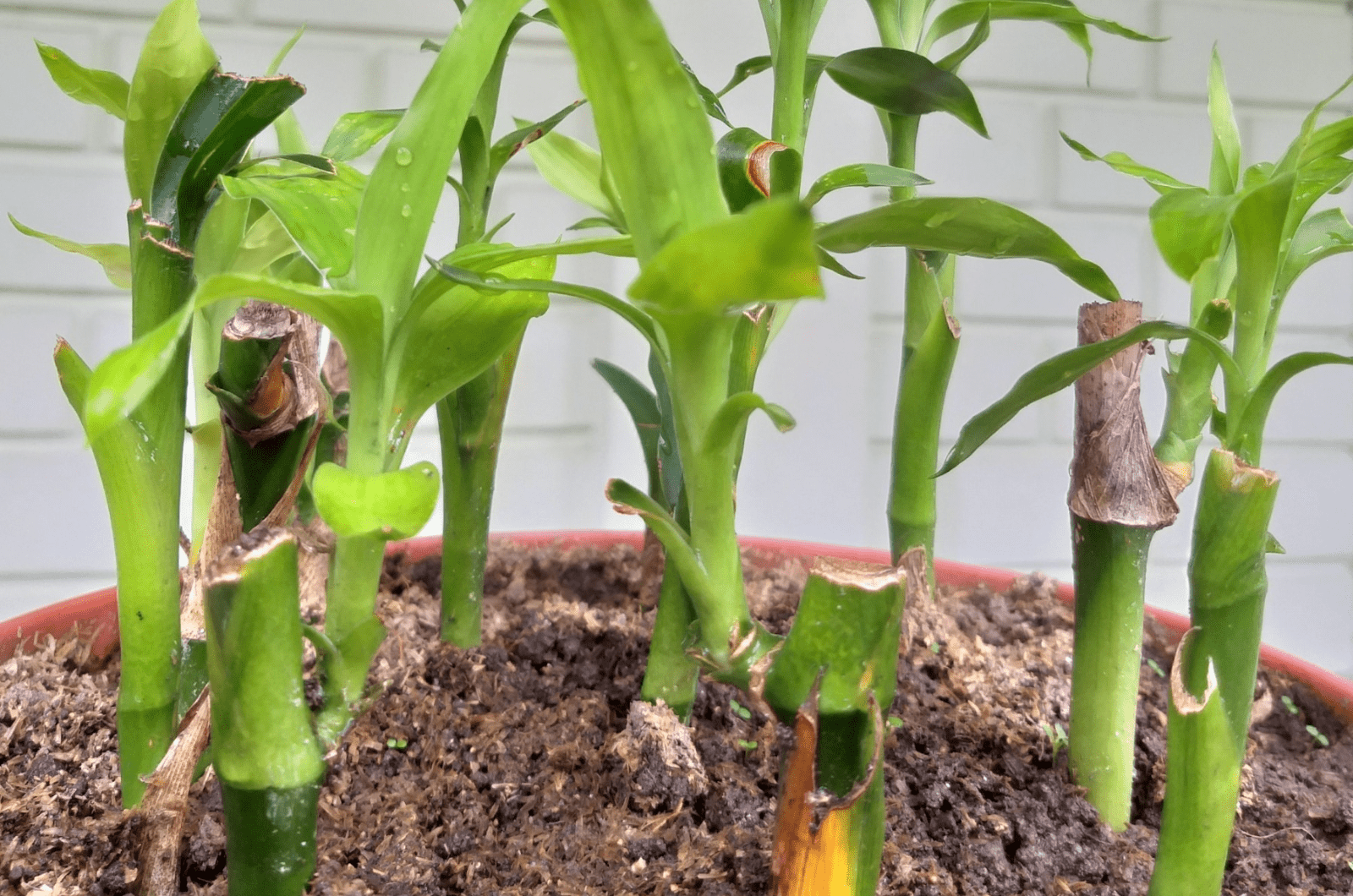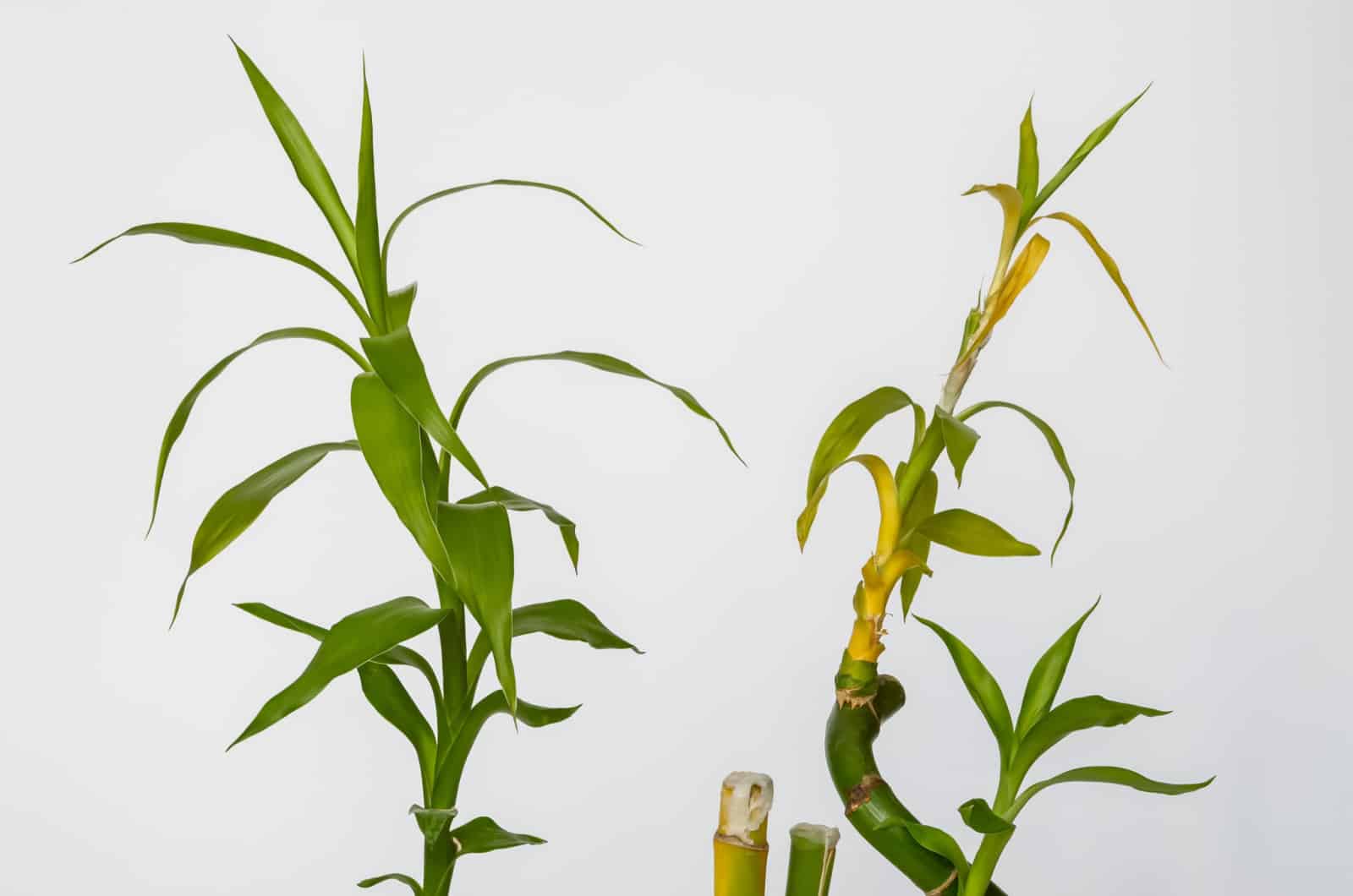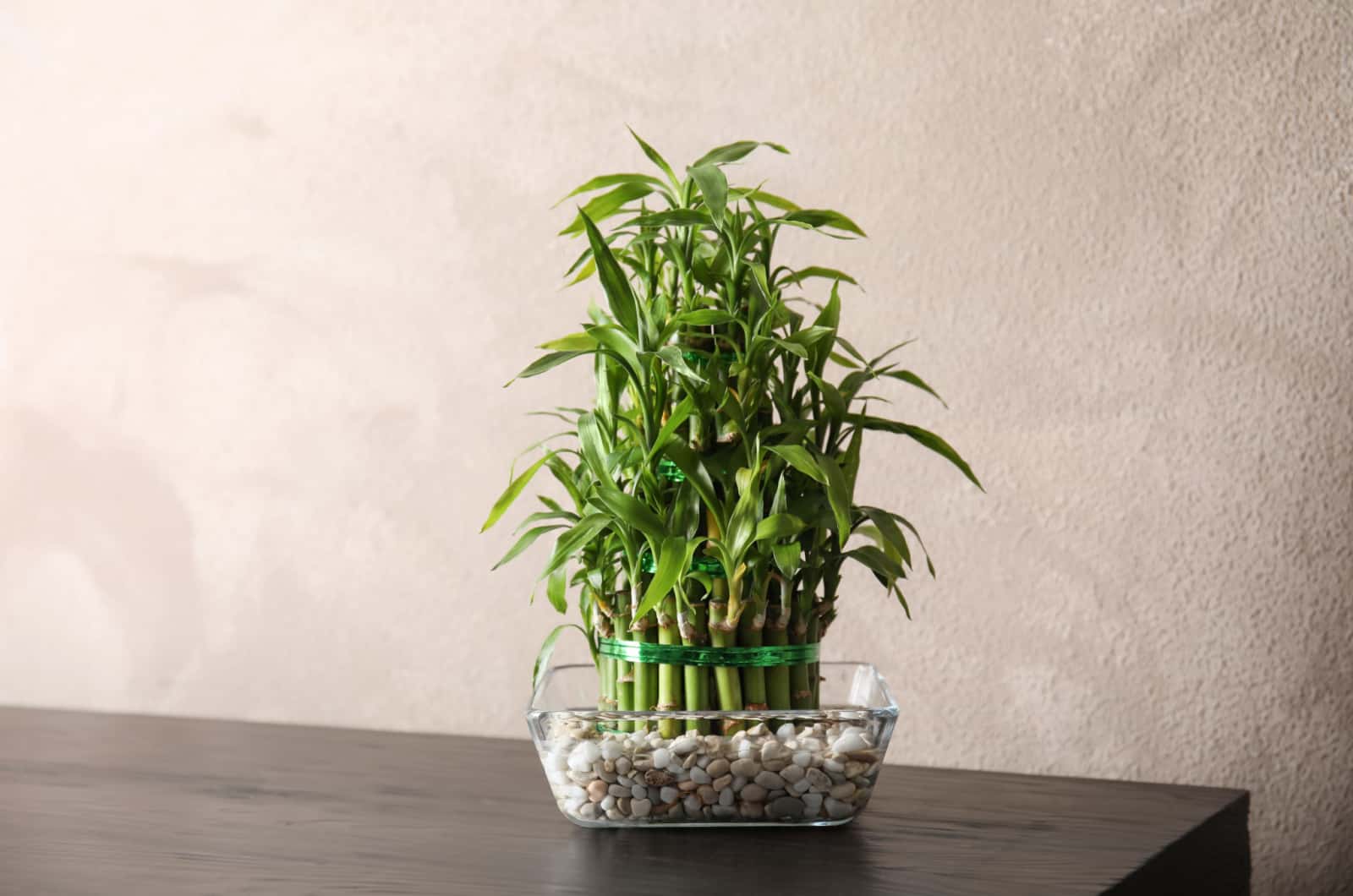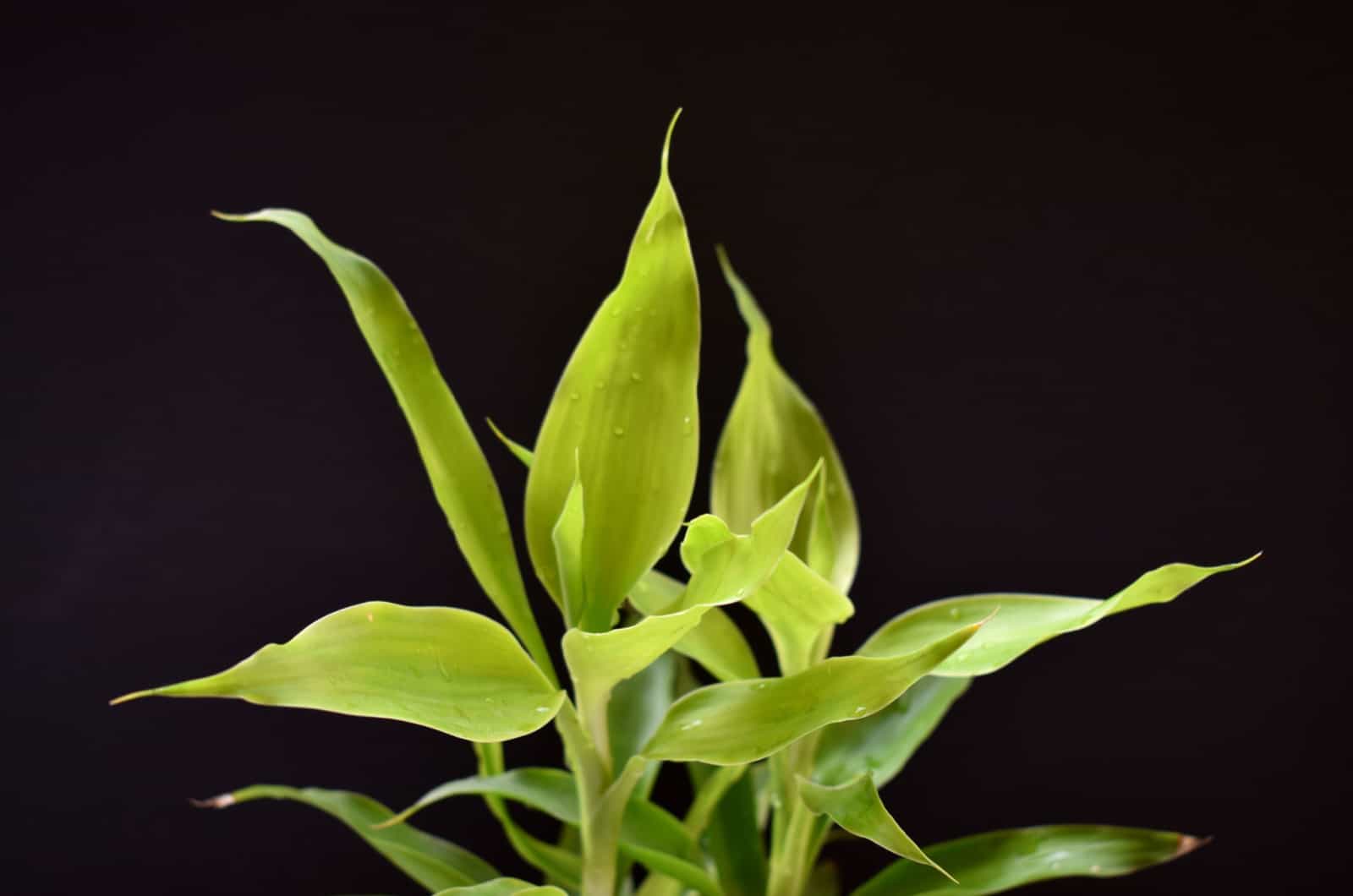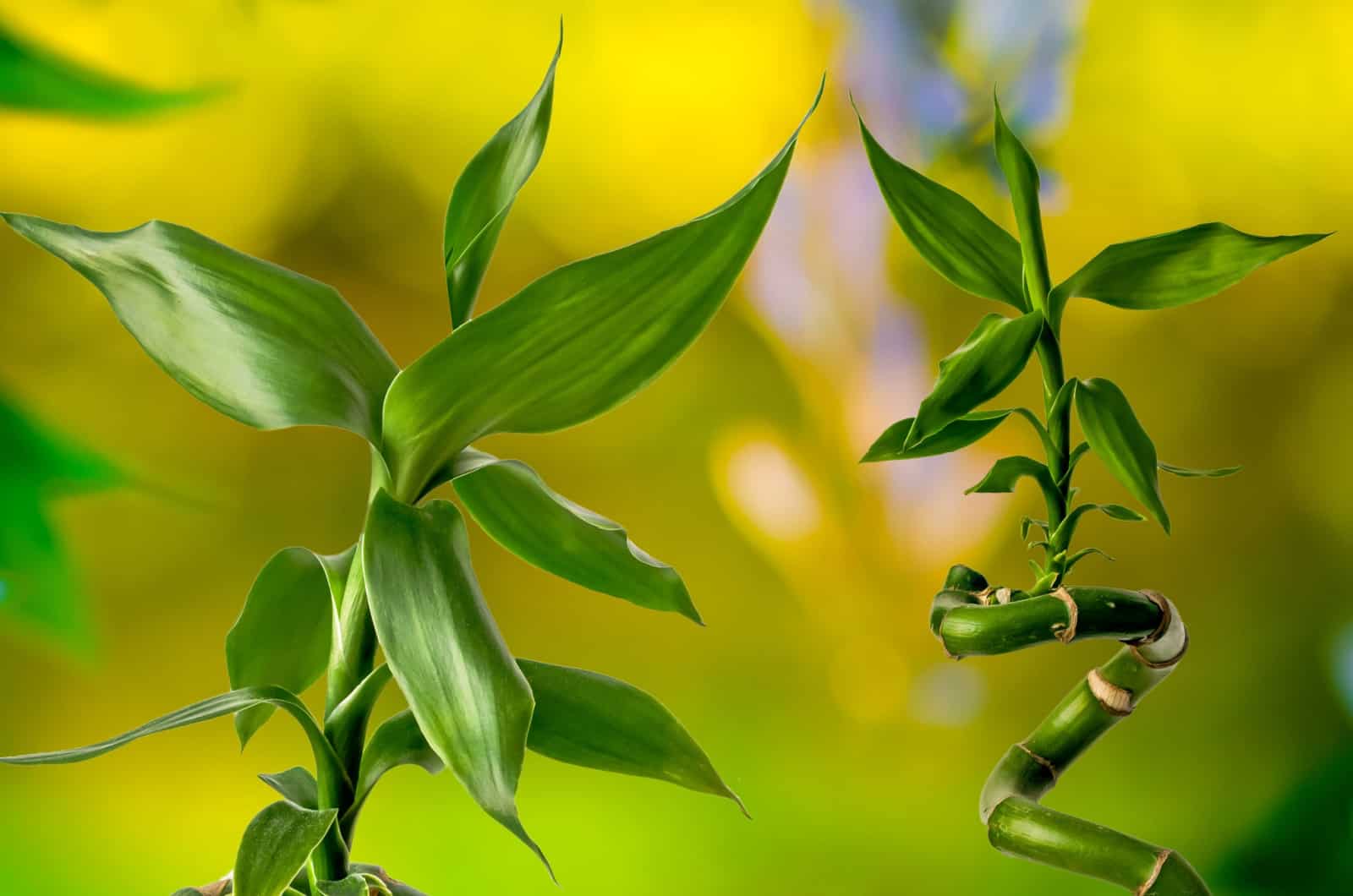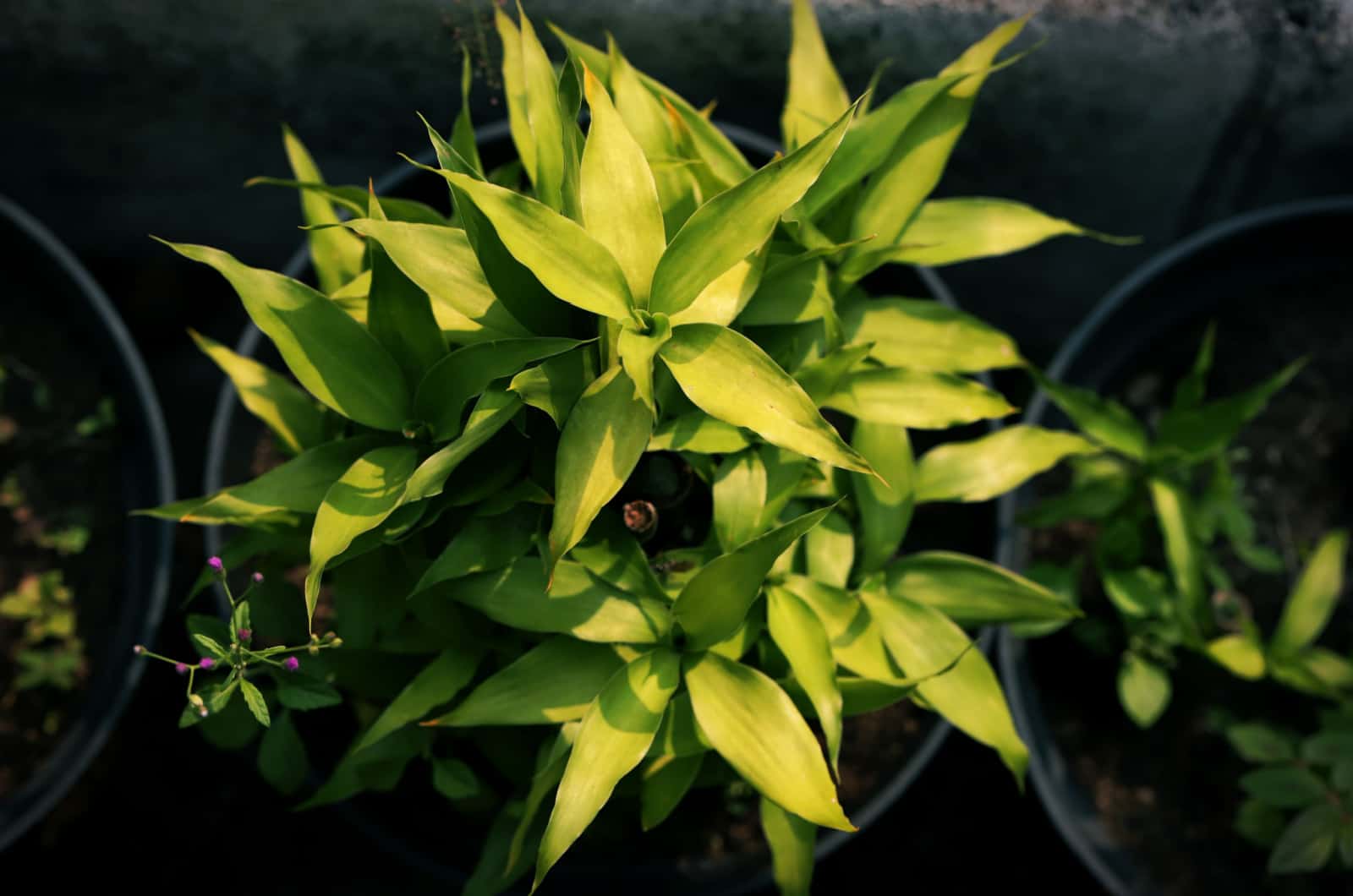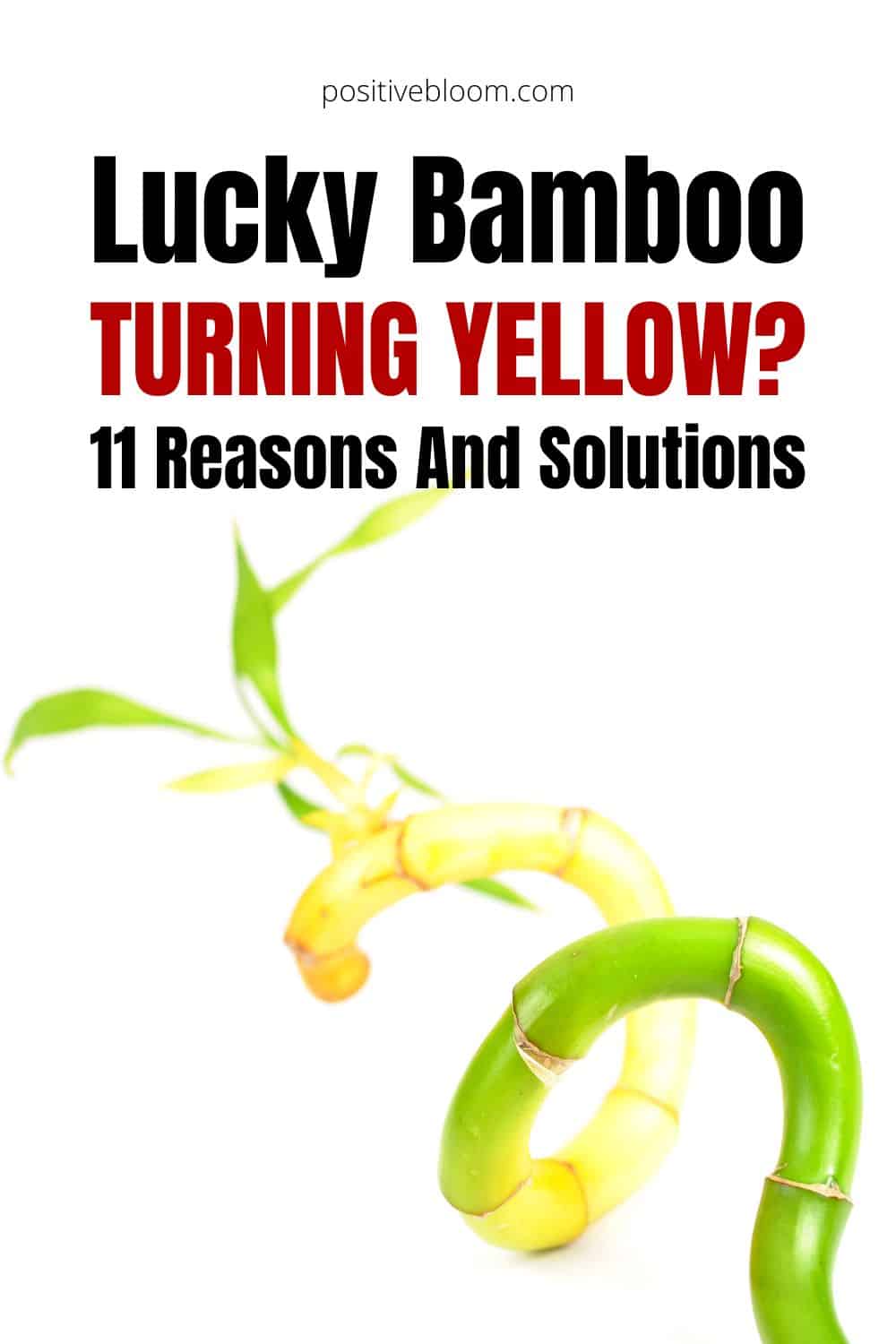Lucky bamboos are one of the most beautiful plants in the world! Interestingly, these plants have nothing to do with bamboo, and are actually considered to be succulent plants.
Dracaena sanderiana, aka lucky bamboo, is known for its low care requirements and ease of propagation. However, just like all houseplants, it’s not entirely problem free.
Is your lucky bamboo turning yellow? Be aware that there are many causes of yellowing; even though some aren’t as dangerous as others, you still need to fix them.
I’ll show you all the possible causes, and some easy ways to fix them and prevent them from occurring ever again.
Let’s get started!
Lucky Bamboo Turning Yellow: 11 Reasons
If your lucky bamboo is turning yellow, it may take a while until you figure out the cause as there are actually 11 possible reasons for yellowing.
Lucky bamboo may turn yellow if exposed to direct sunlight, lacks nutrients, is overfertilized, grows in inadequate temperatures or low humidity, suffers from a disease or pest infestation, has a damaged stem, or receives or grows in the wrong type of water. Your lucky bamboo may also turn yellow due to aging, so don’t jump to conclusions.
Let’s get into details!
1. Direct Sunlight
Lucky bamboo is a plant that grows well in offices with no windows. As you may assume, these are low-light-loving plants that won’t tolerate anything higher than medium light conditions.
Therefore, if your lucky bamboo is exposed to too much sunlight for too long, the leaves will start turning yellow.
This is most commonly followed by wilting, as the full sun also promotes water evaporation, and plants quickly become underwatered.
2. Lack Of Nutrients
Underfertilization or nutrient deficiency often occurs in potted plants. Lucky bamboo, like other indoor plants, need food for healthy growth.
Lucky bamboo needs macronutrients such as Nitrogen, Potassium, and Magnesium; if it lacks any of these, it’ll display yellowing.
Although these plants require micronutrients, they most likely won’t display yellowing in this case.
Nutrient deficiency causes lucky bamboo leaves to turn yellow, but also to wilt and droop. In the case of low Nitrogen, yellow stems will occur.
The growth rate of your lucky bamboo will significantly decrease if it doesn’t receive the nutrients it needs.
3. Overfertilization
We often feed our plants more than suggested as we want them to be healthier and happier, but this is far away from what we should do.
Adding too much fertilizer will result in salt and mineral buildup in the lucky bamboo soil. This will destroy the beneficial microorganisms in the soil and affect the pH level, reducing the lucky bamboo plant’s access to nutrients.
Using fertilizers rich in Nitrogen will boost growth, but the plant roots won’t develop as fast, and the plant will eventually lose its strength.
The most common consequence of overfertilization is leaf discoloration and wilting. Brown and yellow leaves occur, followed by wilting and browning of the lucky bamboo stalks.
4. Too High Or Too Low Temperatures
Although lucky bamboo thrives in different temperature ranges, any extreme leads to problems. Any temperature between 65 and 95 degrees Fahrenheit works great for this Dracaena plant.
If the temperatures are too high, they’ll quicken respiration and cause the plant to lose sugar and starch.
If your lucky bamboo is growing in chilly temperatures, the cells in the leaves will freeze, and further leaf development will be impossible.
In both cases, your lucky bamboo will become weak and the green leaves will start turning yellow, wilt, and may also fall off.
5. Low Humidity
Another potential cause of a Dracaena sanderiana turning yellow is low humidity. When the air becomes drier, it hastens transpiration (the rapid loss of water via leaf pores called stomata).
This means that lucky bamboo plant leaves will lose water faster, and if they don’t receive water quickly they’ll start turning yellow.
6. Pest Infestation
If your lucky bamboo has a thrip or aphid infestation, it will suffer from different complications.
Thrips proliferate ferociously and can fly, making them dangerous for all houseplants.
They can inhabit all parts of the lucky bamboo plant. Both mature and larvae thrips suck on the sap of the lucky bamboo and damage the plant tissue. Tiny holes develop, and your lucky bamboo fails to perform photosynthesis.
Yellow and curly leaves frequently appear, and they start falling off.
Aphids also suck the sap from delicate shoots and leaves, and they typically hide on the undersides of the leaves.
After aphids are done eating, they leave a sticky substance that creates a perfect environment for harmful bacteria.
Your lucky bamboo will start turning yellow, and you need to do something ASAP!
7. Diseases
If your lucky bamboo displays stunted growth or stops growing entirely, and the leaves display yellowing, develop spots, and become soft, root rot disease may be the culprit.
This is a common disease in all plants and happens mainly due to overwatering. Yellowing is the most common symptom of root rot.
If you don’t do anything, all the roots will be affected by the disease and your lucky bamboo might die.
Your lucky bamboo may also display mushy and soft stems, and the leaves will have brown tips.
8. Damaged Stem
The main function of the lucky bamboo stem is to supply the other plant parts with nutrients.
If the stem breaks or bends, it will stop sending water and food to the leaves.
The leaves will start turning yellow, droop, and weaken.
You can damage the stem if you trim your lucky bamboo too often or use blunt tools.
9. Wrong Water Type
Most plants are picky about water type, and lucky bamboo is one such plant. It’s exposed to danger from contaminants in the water that have not been filtered, i.e., tap water. These substances include chlorine and fluoride.
The effects of using tap water take time to become apparent. It is a result of the progressive accumulation of toxic substances over time. These harmful compounds will stop vital plant functions, including respiration and photosynthesis.
Your good luck plant will start yellowing, wilting, drooping, and may even turn brown.
10. Stagnant Water
Lucky bamboo is one of the plants that can grow in water. If you don’t change the water for too long, it will encourage the growth of unsettling creatures.
This comprises mold, fungus, and bacteria that could potentially transmit illnesses or damage the plant.
Stagnant water and too much light are a perfect combination for algae to develop. If algae gets into the container, it’ll start taking the nutrients your lucky bamboo needs.
The leaves will become discolored (yellow or brown) and deformed.
11. Aging
If the yellowing affects new leaves, there’s a reason to worry, but if older leaves start turning yellow it may just be a part of the normal life cycle of the lucky bamboo plant.
Your plant uses energy to produce new growth. As you can see, sometimes yellowing can be entirely harmless, so panicking won’t do any good.
Solutions To A Yellow Lucky Bamboo Plant
I know how stressful it can be to see your lucky bamboo discolored. Yellowing may be dangerous, but if you react on time and fix the issue, your lucky bamboo will thrive again.
Now that you know all the possible answers to the question, “Why is my lucky bamboo turning yellow?”, it’s time to fix the issue.
Fix Light
I mentioned that lucky bamboo grows well in low light. It would be best if you could ensure bright indirect light because it’s the perfect light level for this plant.
Underwatering frequently occurs if your plant receives too much sun as it hastens water evaporation.
It’ll be way easier to figure out the water needs of your lucky bamboo if it grows in bright indirect light.
Placing sheer curtains on the windows is one of the most common ways of preventing intense sun rays from reaching lucky bamboo leaves.
New Fertilizing Schedule
If nutrient deficiency causes yellowing, you need to feed your lucky bamboo. This plant thrives when grown in water, and it can benefit from liquid fertilizer in that case.
Underfertilization is easily fixed, but it may be more difficult to fix overfertilization.
In certain cases, a white substance develops on the top of the soil if there are excess nutrients in it. You need to transfer your lucky bamboo to fresh potting soil in this case.
If there’s no white coating on the topsoil, the best idea would be to wash off the soil using distilled water. Salts and surplus nutrients will come out of the drainage holes.
You need to reduce the use of fertilizer; feed your lucky bamboo once a month during the growing season. Use fertilizers made specifically for lucky bamboo plants, or go with balanced ones diluted to half strength.
If you grow your lucky bamboo in potting soil, I recommend adding a layer of organic compost once a year.
Adjust Temperatures
The Dracaena sanderiana thrives in a temperature range from 65 to 95 degrees Fahrenheit.
These plants are extremely sensitive to temperature fluctuations, so placing them near doors or windows isn’t a good idea.
Always check temperatures on the thermostat, and don’t place your lucky bamboo near heating devices.
Adjust Humidity
If low humidity is the culprit for yellow parts on your lucky bamboo, you need to increase humidity levels.
The best way to increase humidity is by using a humidifier. This device is precise, and some may even have an option for monitoring humidity. However, humidifiers can be pricey, so if you don’t want to spend any money you can use one of the methods below instead.
The pebble tray method is commonly used in indoor gardening. Although many people doubt if pebble trays really work for humidity, from my experience, they can really help.
You just need some pebbles and a shallow dish; put the pebbles into it and pour in some water. Lucky bamboo is a type of money plant that’s excellent for Feng Shui. Placing a pebble tray below the lucky bamboo pot will make it even prettier.
Another excellent method for raising humidity for your precious lucky bamboo is grouping all your houseplants. Not only will the lucky bamboo benefit, but all the other indoor plants will too.
You can also mist your lucky bamboo. This method is short-lasting and should be done more frequently to work, so if you don’t have a lot of free time I recommend using one of the methods above.
Eliminate Pests
The first thing you need to do if your lucky bamboo has a pest infestation is isolate it. It would be best if you did this no matter the severity of the infestation. Aphids and thrips spread rapidly, and what once was only a lucky bamboo problem may soon be a problem for all your houseplants!
Now determine the severity of the damage. If the infestation isn’t severe, neem oil, rubbing alcohol, or insecticidal soap solution will solve the problem.
If using neem oil, combine 1 tbsp of neem oil with 2 tsp of dish wash; this ratio is perfect for a half-gallon of water.
Please pay attention to all instructions as neem oil may burn the leaves if used incorrectly.
It would be best if you removed all severely affected lucky bamboo leaves with sanitized scissors to avoid spreading the infestation to the healthy parts.
If your Dracaena sanderiana grows in water, you need to sanitize the vase and fill it with distilled and fresh water.
If your lucky bamboo has a severe pest infestation, you need to use pesticides.
Treatment For Diseases
The only solution to fungal diseases is a fungicide. If your lucky bamboo suffers from root rot disease, you’ll need to remove the plant from the soil/water, and remove the diseased roots.
Applying fungicide to the root system after removing all affected roots will prevent the infection from spreading. Water your bamboo accordingly to avoid more issues.
Solution To Stem Injury
If a broken stem causes yellowing, you need to remove its upper part. Sadly, this Dracaena plant cannot be grafted; therefore, there is no way to rejoin broken parts. Not everything is lost; by removing the upper part of the stem you’ll make way for fresh sprouts.
Prune the stem with shears slightly above the node. This will promote the development of new shoots.
You can put a layer of soy wax on the cut end to protect your lucky bamboo from contamination.
Look for a wax that is colorless, scentless, and petroleum-free. Put the stem where it initially was; it’ll thrive if provided with enough water and a suitable environment.
Perfect Water Type
To avoid chlorine and fluoride accumulation, stop using tap water.
When discussing the perfect water type for plants, you can choose between rainwater, distilled, or filtered water.
Using rainwater for your plants is the best you can do. If you collect and use rainwater, you’ll avoid harmful substances affecting your lucky bamboo.
Solution To Stagnant Water
The easiest way to avoid stagnant water is by refreshing the water in the container at least once a month.
Harmful microorganisms are less likely to flourish in clean and fresh water. Additionally, clean the vase and pebble stones by washing them with mild soap and rinsing them.
When purchasing vases for your lucky bamboo, choose one made of darker ceramics. Algae need light, and these vases will block the light and hinder the growth of algae.
Alternately, keep transparent containers away from areas that receive a lot of light.
If you are already dealing with algae, here are a few easy steps to fix the issue:
• Take your Dracaena sanderiana out of the vase.
• Soak the roots in fresh and clean water, and clean the pebbles and vase by sprinkling salt and rinsing.
• Put your lucky bamboo back into the vase, add pebbles, and pour fresh water.
FAQs
Can yellow bamboo turn green again?
The yellow parts of the lucky bamboo plant won’t turn green again. To promote new growth, you should determine the cause of yellowing and remove the affected leaves with sanitized scissors.
If the roots are affected, you’ll need to remove all rotten ones and clean the root system with a fungicide.
How to prevent lucky bamboo from turning yellow?
You need to pay attention to all elements of plant care. Lucky bamboo prefers low to bright indirect light. If you grow it in potting soil, make sure it is fertile and has good drainage.
Pay attention to watering; wait until two-three inches below the soil line dry out, and then water your lucky bamboo. This way, you’ll avoid overwatering and damaging your entire plant. Use rainwater or distilled water.
Feed your lucky bamboo with organic compost or fish emulsion. Ensure moderate humidity and warmer temperatures.
If growing it in water, refresh the water at least once a month.
Wrapping Up
Lucky bamboo care isn’t demanding, but it’s not a completely problem-free plant either.
Is your lucky bamboo turning yellow? Now you know all the possible reasons why it happens.
Although the yellow parts won’t turn green again, you can promote new growth by fixing the issue using our advice.
There’s nothing better than seeing your lucky bamboo healthy and happy again. Remember, you can propagate lucky bamboo if it’s healthy to get more of these amazing good-luck plants!
Until next time!Meta: Is your lucky bamboo turning yellow? Read our article and discover all possible causes of yellowing and the best methods to save your lucky bamboo.
Like this post? Share or pin it for later!

